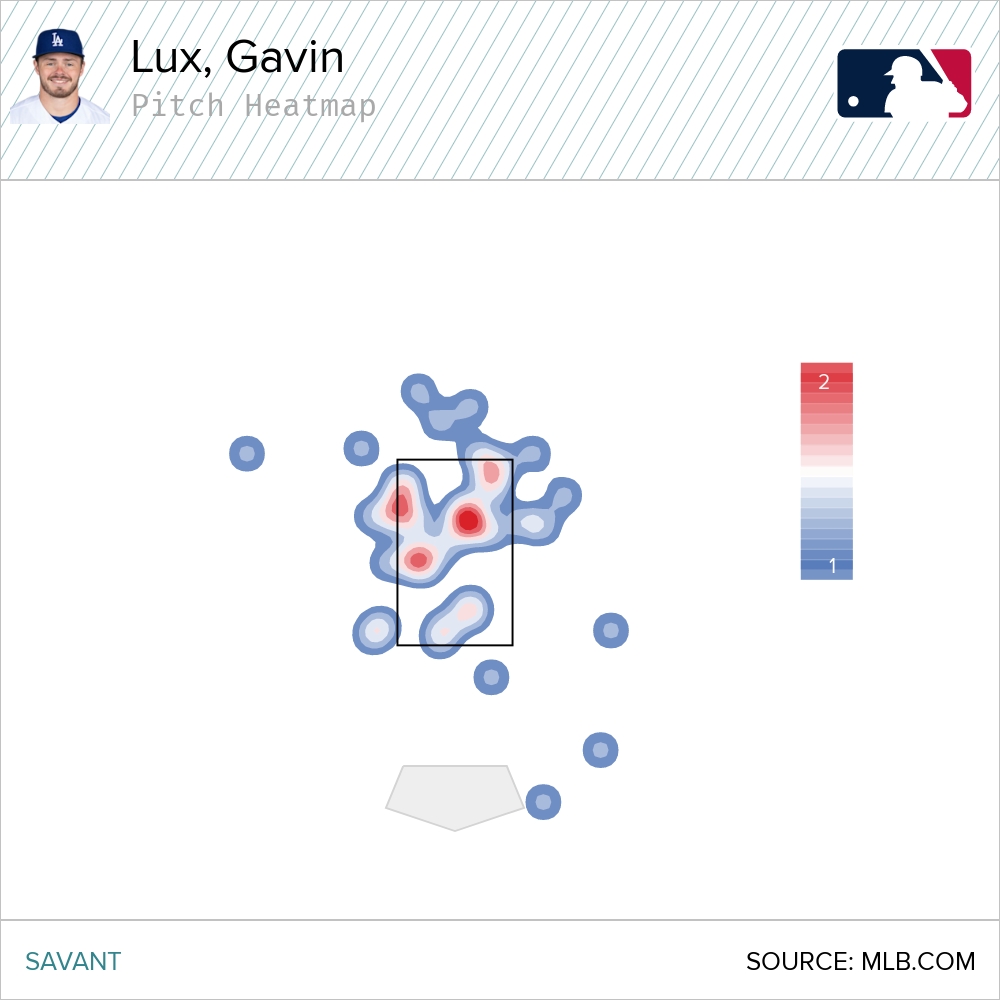It feels a little bit weird to be talking about Gavin Lux as something of a post-hype type, although that falsely implies that he’s already failed to live up to his top-three prospect billing. That’s a function of last year’s lack of a real season more than anything else, and it would be pretty disingenuous to suggest that his pair of September cameos constitute much of an opportunity to establish himself. It just seems like we’re not seeing the buzz that usually accompanies the next big thing when they get their first extended shot at playing in the majors.
That’s what happens when you’re an elite young player with the fortune to be drafted and developed by a franchise that actually has designs on winning before their generational prospects reach the majors. It’s also partly because we’ve been greatly spoiled by the Soto and Acuña and Tatís-types of the world, who have made a habit of setting the world on fire the second they’re called up to the majors.
Lux’s learning curve in the big leagues has been a little steeper than that, at least initially. He put up a cumulative .210/.278/.377 batting line (76 wRC+) over those first 151 plate appearances scattered across his age 21 and 22 seasons, hardly much to get a read on. After entering the spring with expectations of seizing the starting second base job for the eventual World Series winners, Lux crashed pretty badly in 2020, hitting just .169 with a .265 xwOBA and .320 xwOBACON in a 16-game stretch as a starter from late August through mid-September. With little idea of what went on at LA’s alternate site, it seemed like the best hitting Lux did all of last year was of the virtual variety:
But even within 2020’s small sample, he probably wasn’t as overmatched as the results indicated. At a 9.2% BB rate and 27.9% K rate, he walked and struck out close enough to league averages, and fell victim to a horrendous .184 BABIP likely informed by a groundball rate hovering near 50% and a subpar 29% Sweet Spot rate, meaning he wasn’t generating very many ideal launch angles, irrespective of exit velocity. He also pulled the ball just 34% of the time despite staying near or above 40% in that category at every level since rookie ball.
It now appears that whatever inconsistencies Lux had in his swing, approach, and performance might have indeed just been a function of 2020 being 2020, with Pedro Moura of the Athletic suggesting last month that he’s benefitting from the mental refreshment of a clean slate this spring. He’s got six hits and a walk through his first 17 plate appearances, and while he’s already squared up a few bad Rockies, pitchers, he’s also employing his entire skillset to make things happen, turning groundouts into hits and taking extra bases left and right:
That spring speed you’re seeing is measuring up at about 29.5 feet per second, according to Baseball Savant, and it’s the single highest average in the league through the first weekend of play. Critically, it’s helping him get off to this solid start without even making optimal contact. In fact, Lux has yet to pick up a Statcast-defined barrel through 13 balls in play:
That’s still not a bad set of outcomes. Scouting reports have noted that his swing is geared for a relatively low average launch angle. Because he still hits the ball plenty hard, many of those dots in the darker territory just below the barrel zone on the top right (“flares and burners”) are scorched line drives that work just fine from an offensive standpoint, especially with that top-notch speed. That second triple yanked into the right-field corner in the above clip is a prime example. Despite the lack of barrels, he’s still smoking the ball with an average exit velocity above 92 MPH and a .365 expected batting average is still in the top 20% of the league so far. It’s not like he’s getting lucky.
Barrels or no barrels through this short early sample, Lux is no David Fletcher. The power is there, and the barrels will come, which makes his early success without “ideally” squaring it up much all the more encouraging. An early look at Lux’s plate discipline numbers hints at why we might be optimistic for a power surge sometime this year. The sample sizes on batted balls are too small to do anything with, but plate discipline numbers stabilize pretty quickly, and we can already see some early changes to his approach at the dish:
| Season | Pitches | Swing | Zone Swing | Zone Contact | Chase | Heart Swing | 1st Pitch | Whiff |
|---|---|---|---|---|---|---|---|---|
| 2020 | 277 | 41.5% | 61.6% | 78.8% | 21.6% | 61.8% | 29% | 26.1% |
| 2021 | 66 | 48.5% | 77.1% | 85.2% | 16.1% | 88.2% | 11% | 25% |
| MLB AVG | — | 46.9% | 66.6% | 82.2% | 28.4% | 71.1% | 28.9% | 24.3% |
(Source: Baseball Savant)
Last September, Dave Roberts expressed a desire to see Lux step up his aggressiveness at the plate, and so far, he appears to have made the exact kind of change you want to see in a young hitter learning the big league strike zone. He’s dropped his chase rate several points but is still swinging more overall, letting the bad pitches go but letting far fewer good ones sail by him for strikes. That he’s done this while simultaneously improving on his swing-and-miss (so far; it’s worth noting that the Rockies aren’t exactly the standard of what he’ll be facing for most of the year) is a good sign that we’ll eventually see some dividends from his more selective aggression.
Calling it selective is important, because it’s clearly not blind aggression, either. After swinging at the first pitch at a roughly league-average rate in his first couple stints, he’s done so just twice in 18 opportunities so far this season. Some of that is Rockies-related variance, to be sure — having watched every pitch thrown to him this season, I can confirm that a fair share of those were just uncompetitive offerings.
But variation doesn’t necessarily mean luck. The nearly thirty-point jump in swing rate over the “heart” of the plate (as defined by Baseball Savant) makes this look like a young hitter who’s quickly learning to make better decisions after swinging his way into a few too many outs during his first ride around the carousel. Looking at a chart of his 0-0 swings last year, it’s hard to find much rhyme, reason, or approach. If it was over the plate-ish, there was a decent chance he’d offer at it, no matter what type of pitch we’re talking about:
Meanwhile, it’s hard to fault him for being aggressive on the two 0-0 pitches he’s swung at this year, one of which turned into a 100+ MPH single up the middle:
Given his talent, Colorado pitchers approached him with caution over the weekend. They fed him a steady diet of fastballs high and on the outer half while trying to tempt him with breaking balls over the plate but below the zone, but it looks like he may have found a mental approach that aligns with the way he’s being pitched:
FASTBALLS
OFFSPEED+BREAKING
It’s encouraging that the 23-year old is finding ways to square balls up and get on base despite not getting all that much to hit, while simultaneously demonstrating that he’s not going to let hittable pitches sail by and get him into deep counts. He posted an elite 7% K-BB in the minor leagues, which in concert with his clearly improved approach makes me optimistic he’ll improve on the average walk, strikeout, and whiff baselines he’s set for himself so far.
Without over-projecting or getting too optimistic, this may capture a similar dynamic to as the adjustment critical to Yoán Moncada’s 2019 breakout, in which a player with above-average pitch recognition skills learns to harness their discipline to force pitchers to put in the zone without letting a damaging number of easy strikes get past him.
…
Lux is a hotshot former top prospect who lit the minor leagues on fire mere months removed from teenager-dom, but has thus far landed with a bit of a thud at the MLB level. That’s okay! The almost two calendar years since he destroyed Double and Triple-A might feel like eons ago, but for obvious reasons, there hasn’t exactly been a whole lot of developmental time in that span. Besides, though we’ve grown accustomed to the sight of young players becoming stars the second they step into the limelight, development still isn’t so linear for the large majority of prospects.
The fundamentals are very much there with Lux, and they’re only getting better. So far in 2021, the results are coming, even though he hasn’t even seen an optimal spread of results when putting the bat on the ball. The elite speed is clearly manifesting in games, and while returns on his keystone defense are TBD, scouts there have traditionally been bullish.
The Dodgers have done the opposite of leaning on him from day one as they’ve competed for championships, refusing to let him flounder extensively when encountering early rough patches. He may not have emerged with a bang as we hoped, but it seems like there’s a pretty good chance that by end of this season, we’ll remember good and well why the kid from Wisconsin was causing all that fuss.
Photos by Brian Rothmuller/Icon Sportswire | Adapted by Jacob Roy (@jmrgraphics3 on IG)






